A pocket of Norway
In northeast Iowa, Decorah still is Norwegian after all these years.
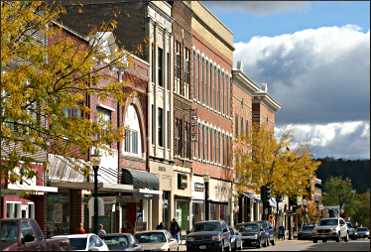
© Beth Gauper
Of all the immigrant groups, Norwegians perhaps are most sentimental.
They settled in hills and valleys reminiscent of their homeland, bringing trunks full of handcrafted ale bowls and mangle boards.
Generations later, they're still painting bowls and stitching costumes in the old style and celebrating holidays with foods poor Norwegians ate in the 19th century.
The heart of this nostalgia is Decorah, a town of 8,500 tucked into the wooded ridges and limestone bluffs of northeast Iowa.
It's the home of Luther College, established by Norwegians in 1861, and Vesterheim, founded in 1877 and now the nation's most comprehensive museum dedicated to a single ethnic group.
Until 1972, it had a Norwegian-language newspaper-the Decorah Posten, which absorbed the Minneapolis Tidende and Chicago and Chicago Skandinaven to become the nation's biggest.
Its Nordic Fest in July is one of the region's biggest and best festivals, drawing 60,000 people for a weekend of Old World immersion where rosemalers paint, acanthus carvers whittle, fiddlers accompany folk dancers, Viking re-enactors fashion mail shirts and street stands sell krumkake, sandbakkels and rosettes, with nary a corn dog in sight.
Tourists from Norway often are surprised by Decorah, commenting that the locals can seem more Norwegian than they are.
"The young people in Norway are more interested in pizza-hamburgers-French fries; it's the Norwegian-Americans who are interested in keeping the traditions alive," says Diane Weston, a clerk at Vesterheim. "It starts to hit in their early '30s; they start realizing it's the thing to do."
Weston herself is only half Norwegian; her father was English, Scottish and Irish.
"And those are interesting cultures," she says. "But this is what I consider endearing, the Norwegian culture."
Lutefisk and ballet
It's true that few things are cuter than a towheaded toddler in a wreath of wildflowers, or a young woman clicking heels in an embroidered bunad, the regional folk costume.
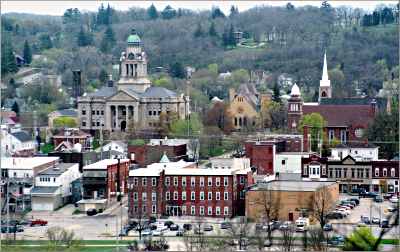
© Beth Gauper
The haunting melodies of a hardanger fiddle, the drawn-out vowels of a Norwegian brogue, the folk-art flourishes on everything — these too are endearing.
And lutefisk? Yes, even that, or at least the locals' willingness to eat it. Once a staple for poor Norwegians, lye-soaked cod now is eaten mainly at Christmas, for tradition's sake.
Despite its allegiance to the 19th century, Decorah always has been a pretty hip little town. Luther College is a magnet for musicians, whose concerts and operas often are free or cut-rate.
National ballet and theater troupes also come to town, and the highly charged cultural atmosphere has attracted artists, who have settled in the scenic hills nearby.
The tidy brick storefronts of downtown always have been pleasant but lacked a great place to stay until 2000, when local angel Helen Basler opened the luxuriously restored Hotel Winneshiek.
The same year, the town's historic homes earned it the title "Prettiest Painted Place in the Great Plains" from the Paint Quality Institute, as judged by Better Homes and Gardens, Architecture and Victorian Homes magazines.
Then the town needed only a fine restaurant; it got two, La Rana Bistro and Rubaiyat Restaurant. The big-city amenities on top of small-town warmth make locals almost giddy.
"This is just an ideal place, and we get to live here," says Kari Burns of the Winneshiek County tourism council. "We don't take it for granted."
If these Norwegians weren't so humble, they'd be insufferable. Not that everyone in Decorah actually is Norwegian.
"It's a proven fact there a few of us Germans here," jokes Charlotte Strinmoen, who came to the area from Berlin as a youth. "It really is a proven fact there are more Germans in the county. But this here is Norwegian territory — lutefisk and lefse, rah-rah-rah."
I met Strinmoen when she was walking with her Norwegian husband, Lloyd, along the paved Trout Run Trail, which follows the Upper Iowa River as it carves an "S" through town, then veers away to follow Trout Run Creek.
Overhead, from a stone gazebo in Phelps Park, another trail follows the wooded bluff top, lined with fanciful pillars of boulders and limestone slabs stacked like dominos.
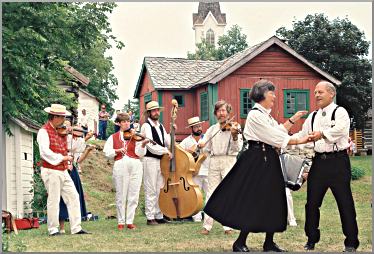
© Beth Gauper
On top of everything else, Decorah has an idyllic setting that draws canoeists, hikers and bicyclists. There's a spectacular view from the bluff, of course, and others from the hill above Dunning's Springs Park, famous for its lacy waterfall, and the trails of Palisades Park.
On the quiet riverside road between the two, Decorah's Ice Cave has been attracting sightseers for a century; in its hillside chambers, ice appears during spring thaw and lasts until late summer.
Near the fish hatchery, just off Trout Run Trail, the famous Decorah eagles have raised dozens of young, avidly watched by millions on webcams.
Decorah's other marquee attraction is Vesterheim, the Norwegian "home in the west" that attracts visitors from all over the world. It's a village in itself, with 15 historic buildings, a four-level museum and a crafts and education center.
It has its own church, its own stone mill and blacksmith shop and its own celebrations: In May, it marks Syttende Mai, which celebrates the day in 1814 when Norway ended its long subservience to Denmark and adopted a democratic constitution.
A dire prophecy
In the museum, visitors learn that the number of emigrants who left Norway between 1825 and 1930 was nearly equal to Norway's 1825 population; only Ireland gave up a greater percentage of its population to America.
There are voices reading the words of emigrant John Nelson Luraas, an eldest son due to inherit the family farm but who still foresaw a bleak future, and Pastor P.A. Jensen, who warned that ". . . Soon will you forget the speech and custom of your fathers . . . And you will live in exile always."
There are the typical contents of an emigrant's trunk, including a delicate china cup and a wooden mangle board, used to smooth clothing.
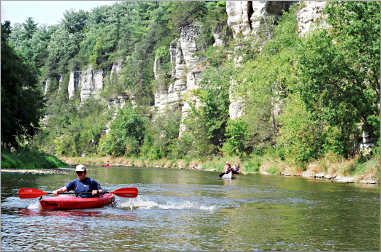
© Beth Gauper
There are exhibits on Norwegians who served in the Civil War, naming their companies "Odin's Rifles" and "Norway Wolf Hunters," and on the heroes of Telemark, members of the Norwegian Resistance whose persistent sabotage prevented Nazi occupiers from producing the heavy water needed to make an atomic bomb.
Vesterheim anchors one end of Decorah's Water Street, with a lineup of shops whose apparent health seems miraculous considering a Wal-mart has sat outside town for many years.
There's a food co-op, a hatchery, a jeweler's, furniture and hardware stores, three women's clothing shops, two bakeries and a mom-and-pop J.C. Penney, the only franchise other than Blimpie Subs and Happy Joe's Pizza Parlor, where a stained-glass "Velkommen" sign hangs over the counter.
And there are bars, unusually tidy and well-lighted, and a tattoo parlor, its windows full of plants and a flier advertising a Decorah Chorale concert.
Spend more than a day walking along Water Street, and you become part of the town fabric.
I first saw Karen LaBat and Sherri Gahring at La Rana, where I was savoring a meal of mixed greens with crayfish tails and avocado, fresh crab cake with truffle-essence mashed potatoes and lemon-curd tart with fresh raspberries and a chopped-hazelnut topping.
I saw the pair again over breakfast at the Hotel Winneshiek, where we discussed the two degrees of separation that seem the norm in Decorah.
"We were at Tupy's, and the woman there said, 'Oh, you ladies have been here awhile,' " said LaBat, associate professor of clothing design at the University of Minnesota.
"She'd seen us walking along the street — typical small town. We said, 'Oh, we're staying at the hotel,' and we had a little restaurant list from the chamber and were trying to figure out where to go, and she told us to go to La Rana. That was the assistant, Robin — you leave knowing everyone's name."
LaBat had come to Decorah to look at Vesterheim's large collection of mittens from the Selbu region of Norway and had brought Gahring, an associate professor of textiles.
On LaBat's advice, I stopped by a Scandinavian imports shop to see Selbu love mittens, which are two pairs of mittens conjoined in the middle so those sentimental — and, apparently, romantic — Norwegians can hold hands.
Up the hill, while admiring the fantastical rock wall of the Porter House, I ran into Vern Ratcliff.
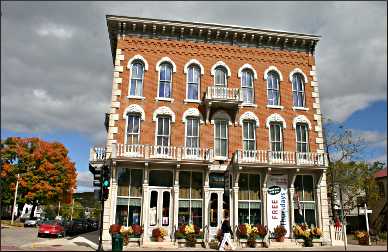
© Beth Gauper
I'd seen him and his wife, Viola, while we were touring Vesterheim and again over lunch; he and Viola had come from Webster City, Iowa, to donate Viola's great-grandfather's discharge papers from the Norwegian navy and application for U.S. citizenship.
It's funny, how wrong that sour old Pastor Jensen was. Not only did the emigrants not forget the ways of their parents, but they never lived in exile — in fact, the Norwegians of Decorah have the rest of the world beating a path to them.
Trip Tips: Decorah, Iowa
Getting there: It's 3 hours south of the Twin Cities and 3½ hours from Des Moines and Madison.
Annual events: Early March, Oneota Film Festival. May 17, Syttende Mai at Vesterheim. Last weekend of July, Nordic Fest. October, Northeast Iowa Studio Arts Tour. First weekend of December, Christmas at Luther concerts and Norwegian Christmas at Vesterheim.
For more about Nordic Fest, see Nordic nirvana.
Vesterheim Norwegian-American Museum & Heritage Center: It's open daily. From May through October, there are 1:30 p.m. guided tours of the outdoors complex. Admission is $12, $5 for youths 7-18, and free the first Thursday of the month.
Paddling: The 31½ miles between Kendallville and Decorah on the Upper Iowa are among the Midwest's most scenic, with limestone bluffs and chimneys lining the river.
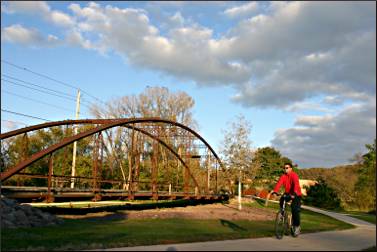
© Beth Gauper
Canoe liveries include Hruska's, 563-547-4566, and Hutchinson Family Farm Campground, 563-382-3054.
In Decorah, Off the Driftless is just up the river from Pulpit Rock Campground and rents canoes, kayaks and tubes.
Hiking: Take Mechanic Street from Water Street downtown up to Phelps Park, where a one-mile trail follows the blufftop above the Upper Iowa River, with limestone steps and terraces built by the CCC.
Bicycling: The 11-mile Trout Run Trail circles the town, along the Upper Iowa River and Trout Run Creek and past the fish hatchery where the famous Decorah eagles nest. It's beautiful, lined with art works and flat except for the south section, which uses switchbacks to climb hills.
You can rent a bike at Decorah Bicycles on College Drive, 563-382-8209.
Accommodations: The Hotel Winneshiek right on Water Street is the place to stay, with 31 very handsome rooms and suites.
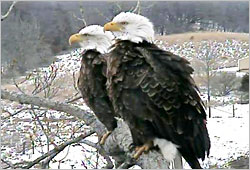
© Raptor Resource Project
On or near Iowa 9, on the southern edge of town, there's a Super 8, 563-382-8771, Quality Inn & Suites, 563-382-2269, and Country Inn & Suites, 563-382-9646, all with continental breakfast.
Bed and Breakfast on Broadway is near downtown and has five rooms.
There are also quite a few Airbnbs in Decorah.
Camping: The municipal Pulpit Rock Campground is on the Upper Iowa River and Twin Springs trout stream, across from Will Baker Park west of downtown. It's also right off the Trout Run Trail.
It has a canoe landing and showers, and sites are first-come, first-served — if you use a tent, get one right on the river. 563-382-9551.
Chimney Rock Campground, on the Upper Iowa River 15 miles northwest of town, rents cabins as well as campsites.
Dining: La Rana Bistro is a gem on Washington Street, serving fresh and original fare at cafe prices. It has an amazing beer list and well-priced wines. It's small, so reserve at 563-382-3067.
Rubaiyat Restaurant on Water Street serves a seasonal menu of classics with a nouveau twist and has an extensive wine and beer list, plus nearly three dozen beers on tap. 563-382-9463.
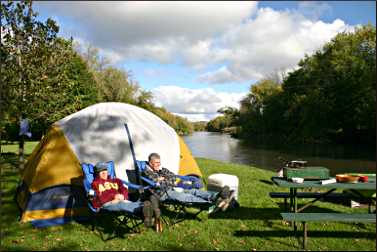
© Beth Gauper
Pick up sandwiches and snacks at the Oneota Community Food Co-op on Water Street.
For coffee and breakfast, Java John's on Water Street is sunny and cheerful. Magpie Coffeehouse on Winnebago Street also is a convivial place to have a ciabatta egg sandwich, smoothie or a mocha.
Eight miles northeast of town, Luna Valley Farm holds pizza nights Fridays and Saturdays from June through September and Fridays in May and October. It also offers glamping in platform tents.
Get a cone at the Whippy Dip, on College Drive west of downtown.
Breweries: Pulpit Rock Brewing has a taproom on College Drive, between Luther College and downtown, and Toppling Goliath has a large taproom on the southeast edge of town, just beyond the airport. It offers tours.
Porter House Museum: This 1867 Victorian house at 401 W. Broadway is open from May through October, but go any time to see its remarkable rock wall and lovely gardens.
Nightlife: There's always something going on around town or at Luther College, often at its Center for the Arts.
Information: Decorah tourism, 800-463-4692.
Nearby attractions: On a heritage farm six miles north of Decorah, Seed Savers Exchange grows and sells rare heirloom seeds and garden gifts.
Near the Minnesota border, the Laura Ingalls Wilder Park & Museum in Burr Oak preserves one of the famous author's homes and is open for tours.
In nearby Spillville, the Bily Clocks/Dvorak Exhibit shows magnificent carved clocks and memorabilia from Czech composer Antonin Dvorak's visit.
For details, see Road trip: Northeast Iowa.